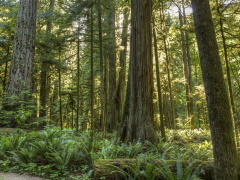Features
Golden goose of the forest
Date: 2020-03-26 10:11:11.0
Author: Jon Evans

Natural forest in North America.
Photo: Colin D. Young/Shutterstock.
Should we be taking more advantage of wood or less? At the moment, we are taking more advantage: not only is wood increasingly replacing coal in power stations for energy generation but scientists are finding more and more uses for it, from water-purification filters to flexible battery electrodes to optical fibers (see Cutting-edge cellulose). In a recent paper in ACS Nano, scientists even showed that it could make an effective catalytic support material.
Wood is being utilized for all these applications because, unlike fuels and materials derived from fossil fuels, it is renewable and supposedly carbon neutral. Any carbon dioxide released as a result of trees being cut down and their wood being utilized in some way, whether burnt or processed, is taken up by the growth of new wood. But several researchers have questioned whether this actually happens, or at least happens quickly enough to make a difference (see Bioenergy crops: problem or solution?).
The release of carbon dioxide from utilizing wood obviously happens over very short timescales, while the taking up of carbon dioxide by growing trees happens over much longer timescales. In the short term, therefore, cutting down trees and utilizing their wood increases the concentration of carbon dioxide in the atmosphere, making global warming worse. Furthermore, if the wood being utilized comes from hardwood trees in established, natural forests, while the new growth comes from faster-growing species such as pine, then not all the released carbon dioxide will be taken up, because pine trees don’t sequester as much carbon dioxide (see Can’t see the wood for the trees).
This has led researchers such as William Schlesinger at the Cary Institute of Ecosystem Studies in Millbrook, US, a long-time critic of bioenergy and its supposed environmental benefits, to argue that the focus should be on reducing global warming by expanding forest areas. Rather than by utilizing wood from those forests.
Now, a new study has entered the fray. Conducted by three US researchers and reported in a paper in Science Advances, it concludes that there is no such trade-off, because greater demand for wood can actually promote forest growth and reduce global warming.
Unlike previous studies on this issue, this one specifically looked at the effects of economic incentives and government policies on wood demand and forest management. To do this, the researchers, led by Adam Daigneault at the University of Maine, used a global dynamic forest model to compare timber harvesting and management in more than 200 managed and natural forest ecosystems around the world.
This revealed that higher timber prices generally lead to more forest growth, with every 1% increase in timber prices causing the area of forests grown for wood production to increase by 0.32% globally. But high prices on their own were not sufficient, because when combined with low levels of timber demand, they could actually lead to more deforestation and higher levels of global warming. This is because the high prices would be sufficient to encourage timber to be harvested from existing forests, but the low demand wouldn’t be sufficient to encourage any investment in forest regeneration. Existing trees would be cut down, but would not be replaced by the growth of new trees.
In contrast, at high prices and high levels of timber demand, there would be the necessary economic incentives to invest in forest regeneration, because landowners would want to ensure they could continue to meet the high levels of demand. They would not want to kill the golden goose.
This demonstrates the importance of governments implementing the right policies to encourage timber demand and forest regeneration, especially the regeneration of natural forests. Under the scenario for the greatest timber demand, the model predicted that Earth’s forest cover could increase by 30% by the year 2100, greatly helping to mitigate global warming.
So, with the right mix of economic incentives and government policies, increasing the use of wood will also increase the growth of forests. A win-win result if ever there was one.
The views represented here are solely those of the author and do not necessarily represent those of John Wiley and Sons, Ltd. or of the SCI.
Displaying 2 keywords used to tag this article:
- DG6582 Mens Moncler Down Jackets Gr
- Jules Audemars-Australia Best Quali
